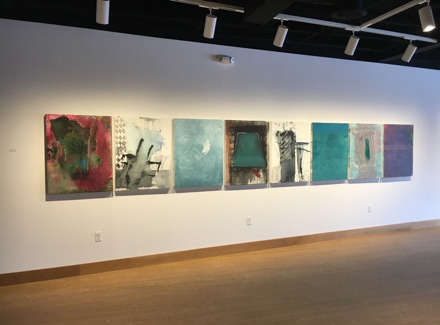A New Exhibition by Bahar Behbahani

Does beauty exist, untainted? If an argument, or a tragedy, occurs in your favorite room, can it remain your peaceful place or is it changed? If so, is it forever ruined, or does beauty subsume any ugliness in its midst? Artist Bahar Behbahani asks these questions in her exhibition, Let the Garden Eram Flourish, just opened at the Hood Museum’s Hood Downtown in Hanover, New Hampshire.
Iranian-born and Brooklyn-based, Behbahani says that she began this series of thirteen paintings as “an inquest of identity. . . the idea of Persian gardens is indexed in an average Iranian person’s consciousness.” Persian gardens have been places of repose and beauty, so important to Persian culture that Persian rugs were created to bring the elements of the garden indoors. In fact, Behbahani has described herself as “a person who grew up surrounded by poetry and carpet.”

Beauty abounds in the paintings displayed on the white walls of this spare space. The initial reaction is to color, shades of blue evoking the importance of water, and reds from dark to pink that might represent the garden’s flora, often roses. The paintings are impressionistic rather than representational, although the form of the garden and its components sometimes breaks through. The beauty might have been enough, but there is more. This exhibition tells a geopolitical and more nuanced story.

In preparing for this project, Behbahani researched the history of Persian gardens and the literature surrounding them. Over past centuries, Western travelers, as part of their Orientalism—a world view that mischaracterized the culture of the Middle East—saw the gardens in overly romantic terms. Behbahani read their prose, the books they had written and even their letters home, describing what they had seen. In more modern times, Donald Wilber, an American, was a recognized authority and writer on Persian architecture; Behbahani had read his work while she was a student in Iran. In 2000, The New York Times revealed that Wilber was actually a CIA operative who was responsible for the 1953 coup that overthrew Iran’s democratic government. The then prime minister, Mohammed Mossadeq, was subjected to arrest—in his garden.
It caused Behbahani to see the garden in different ways. “Brutal experiences” such as murder and other forms of social and political mayhem in Iran’s history have taken place in gardens. Behbahani has used historical documents, garden blueprints, and stories from her childhood to try to piece together this more complex portrayal of the garden’s significance beyond just the aesthethic.

Crucial to her vision is one of the panels: The Decisions Are Made: Activity Begins, that is by design front and center, facing the gallery’s entrance. Like the other canvases, there are layers—of paint, of figures that rise from and recede into the background, layers that indicate how we come to know—bit by bit, one informing or contradicting the other. What sets this panel apart, however, are the thin black rectangles that randomly interrupt. They are familiar to anyone who has seen a document in which information has been “redacted,” or hidden from view. In a far corner of this exhibition is a document, previously published by The New York Times, that reveals Donald Wilber’s secret involvement in the 1953 coup. It is shot through with the same thin black rectangles. The canvas asserts that the only certainty in our knowledge is that there are things we do not know, perhaps will never know, and may even be purposefully denied us.
This exhibition extends beyond the panels to involve other media. One wall holds a “fractured” non-linear timeline about Iran’s history and gardens and a viewing case of related artifacts, as dark as the redacted Wilber documents and as darkly comical as a note about Lord Tennyson, who took up badminton after his wife dissuaded him from studying Persian because the alphabet was “peculiar.” On a facing wall, there is a video, Visiting You In Summer, of a modern garden in Iran featuring a brief cameo by the artist’s mother.

Bahar Behbahani appreciates new intricacies and previously unknown coincidences. The famed and ancient Eram Garden from which this exhibition takes its name is now part of the campus of Shiraz University in Iran. That campus was designed by architect Minoru Yamasaki, who famously designed New York’s original World Trade Center. He had installed a fountain there, with benches for sitting. He described it—as one might a Persian garden—as “an oasis, a paved garden where people can spend a few moments to relieve the tensions and monotonies of the usual working day.” Behbahani discovered the coincidence of his having designed both projects while working in her studio, which itself happens to overlook Ground Zero in New York City. Yamasaki’s work and garden are gone, but Behbahani passes the 9/11 memorial fountains each day, and listens to the sound of water.
Let The Garden Eram Flourish will be on exhibition at the Hood Downtown, 53 Main Street, Hanover NH, until March 12, 2017. For more information and for gallery hours, please see the Hood Museum’s website. Admission is free.
*All quotations are from “History As A Context of Artistic Practice: Ugochukwu-Smooth Nzewi in Conversation with Bahar Behbahani” (program brochure), exhibition materials, and conversations with the artist. Behbahani’s work is also currently on exhibition at the 11th Shanghai Biennale.
Originally published on dailyUV

